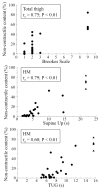Relationships of thigh muscle contractile and non-contractile tissue with function, strength, and age in boys with Duchenne muscular dystrophy
- PMID: 21807516
- PMCID: PMC3215817
- DOI: 10.1016/j.nmd.2011.06.750
Relationships of thigh muscle contractile and non-contractile tissue with function, strength, and age in boys with Duchenne muscular dystrophy
Abstract
The purpose of this study was to assess the contractile and non-contractile content in thigh muscles of patients with Duchenne muscular dystrophy (DMD) and determine the relationship with functional abilities. Magnetic resonance images of the thigh were acquired in 28 boys with DMD and 10 unaffected boys. Muscle strength, timed functional tests, and the Brookes Lower Extremity scale were also assessed. Non-contractile content in the DMD group was significantly greater than in the control group for six muscles, including rectus femoris, biceps femoris-long head and adductor magnus. Non-contractile content in the total thigh musculature assessed by MRI correlated with the Brookes scale (r(s)=0.75) and supine-up test (r(s)=0.68), as well as other functional measures. An age-related specific torque increase was observed in the control group (r(s)=0.96), but not the DMD (r(s)=0.06). These findings demonstrate that MRI measures of contractile and non-contractile content can provide important information about disease progression in DMD.
Copyright © 2011 Elsevier B.V. All rights reserved.
Figures






References
-
- Hoffman EP, Brown RH, Kunkel LM. Dystrophin: the protein product of the Duchenne muscular dystrophy locus. Cell. 1987;51:919–928. - PubMed
-
- Kapsa R, Kornberg AJ, Byrne E. Novel therapies for Duchenne muscular dystrophy. Lancet Neurol. 2003;2:299–310. - PubMed
-
- Tidball JG, Spencer MJ. Skipping to new gene therapies for muscular dystrophy. Nat Med. 2003;9:997–998. - PubMed
-
- Liu G-C, Jong Y-J, Chiang C-H, Jaw T-S. Duchenne muscular dystrophy: MR grading system with functional correlation. Radiology. 1993;186:475–480. - PubMed
-
- Liu M, Chino H, Ishihara T. Muscle damage progression in Duchenne muscular dystrophy evaluated by a new quantitative computed tomography method. Arch Phys Med Rehab. 1993;73:507–514. - PubMed
Publication types
MeSH terms
Grants and funding
LinkOut - more resources
Full Text Sources
Medical

